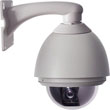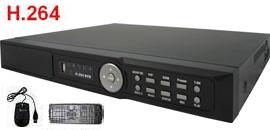Getting to Know Surveillance /
DVR Remote Monitor Access Setup
Getting To Know Surveillance
Surveillance Hardware
How
to select Video Cameras?
Can
it record sound at the same
time?
How
do I record surveillance videos? What equipments do I need?
What
is Network DVR?
What
is IP Camera?
What
does Illumination stand for? What is Resolution?
What's the difference between CCD and CMOS
image sensors?
What
is BLC?
What
is AWB?
What is AES?
What's its difference with Auto-Iris?
What is Wide Dynamic Range?
Surveillance Hardware
To
perform video surveillance, you'll need the following,
Video Cameras: For the purpose of capturing videos.
Display Monitor: A display monitor for a user or a security staff to
monitor the surveillance site in real-time, and for viewers to see the recorded
video clips. The monitor can be a professional surveillance monitor, a TV, a computer
monitor or a small LCD screen.
Storage: A traditional VCR, a Digital Video Recorder, a
computer or other Video Storages for backup and search purposes.
Power supply: Power Supplies for both Video Cameras and storage device.
Cabling: For most CCTV cameras, it requires proper cabling between
video cameras and the storage device. The most commonly used CCTV
cables are coaxial cables (RG59, RG60) and Ethernet cables (CAT5,
CAT6).
How to select Security Cameras?
Type of Security Cameras:
| Type |
Picture |
Usage |
Installation &
Remarks |
| Dome |
 |
Due to its
unobtrusive
nature, Dome Cameras are frequently used in
offices, stores, homes and elevators.
|
Dome cameras are mostly installed indoors on
the wall or on the corner of the ceiling.
|
| Bullet |
 |
The
size of a bullet type camera is similar to a dome type camera. Most
bullet cameras are designed to be water-proof,
and some are even weather-proof,
that could sustain stressful temperature changes. However, that also
contributes to their relatively higher prices.
|
It normally comes with a small
bracket attached, and is applicable for outdoor
installation. |
| Standard / Box |
 |
The
good old box type camera
is good at thwarting crime intentions. It is normally more conspicuous
in both size and shape.
Box
type cameras are more
flexible in adapting lens of different focal lengths for
optimum
zoom of the surveillance targets.
|
A box camera would need a bracket for
installation. And rain-cover housing is required for outdoor
installation.
|
| Covert |
 |
A covert camera,
or hidden camera, is designed to be invisible or is disguised
as another object such as a smoke detector or a motion sensor. |
Installing and
operating covert cameras would incur privacy
infringement concerns. In general, it requires consent from the
recorded
persons.
|
PTZ/
Speed Dome |
 |
A PTZ camera can Pan and
Tilt the direction
of the camera and zoom the focus to track the surveillance
target
through a remote control panel or through a DVR. |
|
Color .vs. Black & White
The good old black and
white security cameras are gradually replaced by the color ones.
However, for most of the mid-end color cameras with night vision feature; their color image will turn into black &
white when night vision is activated under dark environment.
Video Cameras with Night Vision
Traditional design of night vision camera is simply adding a motion
detection sensor. The sensor will turn on a light when a motion has been detected.
Modern
Night Vision cameras are mostly utilizing the Infrared technology.
Among
them, IR cameras
are the most commonly found. The idea is to combine illumination of
infrared spectral range with CCD sensor sensitive to this light. The
resulting scene is a monochrome image. That explains why a
color
IR video camera will turn into monochrome one when IR is activated.
Though, adding an IR filter could enable night vision for a Video
Camera, it also inflicted a side-effect that introduces some
minor
color change on the color videos.
Another
Night Vision Video Camera called ICR (IR Cut Removal)
Camera is designed to solve the aforementioned problem. Due to
their ability to possess night vision while retaining the true color
nature under sufficient ambient light, they are also called True
Day and Night Cameras.
The
last Night Vision video camera we'll introduce is Day and
Night Color Video
Camera. As the name implies, the camera is able to take true
color
images at very low luminance level, such as 0.0003 Lux or lower. The
designs are
either using larger image sensor or using sensor with higher
sensitivity or both. Thus, Day and Night Color Video Cameras are
inevitably more expensive and are used in special applications.
Analog Video Camera .vs. Digital Video Camera
The
criteria in defining
whether a video camera is Analog or Digital, depends on its
output
signal format. Since the traditional backbone of surveillance device
are VCRs which takes analog inputs, most surveillance cameras are
designed to output analog signals. Thus, even when the technology has
evolved into digital era, the most commonly found
cameras still output analog signals, even though its back-end
image
processing mechanisms are mainly in digital form. Before sending out
the signal, it
converts its digital signal into analog one to comply with the
VCR's input format.
The
analog video camera follows the same transmission standard of either NTSC or PAL as
the traditional analog televisions does. Thus, no matter how high its
image sensor
resolution is, the resulting output signal is still constrained within
720 x 480(NTSC) or 720 x 576(PAL). On the other hand, the digital video
camera doesn't have such constraint and is free to expand its
resolution as long as the technology can support.
Does surveillance camera record sound at the same
time?
Most
Video Cameras are
not equipped with sound recording feature. Besides privacy concerns,
the recorded sounds are not very practical in identifying the suspects
in a scene. However, some covert cameras do support sound recording
features, and they are mostly used in a detective surveillance
purposes. And since most of the Video Recorders do support at
least one Audio-In channel, user can purchase a multi-directional
microphone to do the recording.
How
do I record surveillance videos? What kind of equipments do I
need?
A video
camera
itself does not record video. To record all or part of the surveillance
videos, you'll need a video recorder. The Digital Video Recorder,
or DVR, is currently the mainstream video recorder in
the
surveillance industry. DVRs can be further divided into
standalone DVRs and PC-based DVRs.
A
standalone DVR is
designed to record video streams from multiple video cameras.
Its
basic function is to capture video frames streamed from the video
cameras, display them on a screen for real-time
monitoring, compress the captured data and store them in
a disk drive, USB memory stick or SD memory card or other
storage
devices. The number of video-in channels ranges from 4, 8, 9 to 16 or
more.
A
PC-based DVR is a
Personal Computer with one or more video capture cards. Each capture
card is able to support 4, 8 or more video channels depending on the
video capture card capacity.
Compared
to PC-based
DVRs, standalone DVR requires less maintenance and simpler
setup.
However, unlike the versatility of PC-based solutions, standalone DVRs'
functions are barley changeable.

What is a Network DVR?
A
DVR with
networking capability is called a Network DVR. Nowadays, the mainstream
DVRs are mostly equipped with networking capability. With a Network
DVR, user can access the DVR either locally with panel buttons and
remote
control, or remotely through the PC web browser.
What is an IP Camera?
An
IP Camera or network
camera is basically a digital camera embedded with Internet Protocol
Module and a web server. Thus, after connecting it onto the network, it
acts like a combination of a video camera and a Network DVR without
storage.
User can use a Web Browser to view the captured video and control its
Settings.
The
IP camera inherited the advantage of digital video camera in its
flexibility of resolution expansion. However, it also comes with higher
cost compared to an analog video camera.
What does Illumination
stand for? What is Resolution?
Illumination
is the
measure of the intensity of light. For a video camera, the lower the
illumination requirement the better it is in accepting low ambient
light images. The unit of illumination is Lux. A
regular day
type
video camera's minimum illumination requirement is at around
0.1Lux to 1Lux.
The
Resolution of a analog video camera is defined by the term TV
Lines (TVL). An introduction of the TV
Lines measurement can be found here.
Normally a higher TVL value means better video quality. However, since
TVL is difficult to verify, it is a relatively good guidance to check
on its image sensor resolution which is calculated in pixel counts. For
example, under the same condition, an image sensor with pixel count of
771 x 494 would produce better image quality than a sensor
of 580 x 470 pixel count.
What's the difference between CCD and CMOS
image sensors?
An
image sensor is a device that was used to convert optical images into
electronic signals. Nowadays, CCD and CMOS are the two most commonly
used technologies to do the conversion.

The
major advantage of CCD
sensor is that it outperforms CMOS sensors in its light sensitivity.
Moreover, its early maturity of technology also makes it the
dominant image sensor utilized in the video camera industry.
A
CMOS sensor, also known as Active
Pixel Sensor (APS),
consumes less power than a CCD one. Though, a late comer regarding to
its development history, its prevalent applications in the IC industry
and hence
lower manufacturing cost is pushing it fast forward
to become the
next generation image sensor in the coming years. Yet,
currently, most CCD video cameras still outperform their CMOS counterparts in the
performance of the color image presentation, especially in low light
conditions.
What is BLC?
BLC is the acronym of Backlight Compensation.
When taking an image of an object, if there is a strong back-light in
the scene, the object will be darker than it actually is, i.e.
underexposure. This is because the video camera calculates and
adjusts its light exposure according to the average amount of light
source detected. When there is a highly contrasting light
source in the scene, the average will be shifted upward, and
in response, the camera will lower its
exposure. Thus, BLC
is designed in a way that when the video camera detected a highly
contrasting light source in a scene, it automatically increased the
exposure by a predefined amount.
Although BLC
can solve the underexposure problem, the increased exposure
also leads to the overexposure of the strong light area. A quick fix to this
problem is to arrange the video cameras in a way that each one
covers an area with similar light intensity, for instance, one camera
for indoor surveillance, and the other one for outdoor surveillance.
Moreover, a technology called Wide Dynamic Range (WDR)
is introduced to solve this problem.
What is AWB?
Auto White Balance (AWB) is a technique to correct or to improve the color of a scene
by manipulating the intensity of the basic RGB color elements. Its purpose
is to make the scene more natural and appealing to viewers.
 |
 |
| Image captured without white balance |
Image after white balance |
What is AES? What's its difference with Auto-Iris?
AES is the acronym of
Auto Electronic Shutter. An Automatic Electronic Shutter controls the
duration at which image sensor is exposed to the light. It determines the exposure time and helps
delivering the best quality video by dynamically adjusting for the
current light conditions by diminishing exposure in a bright
situation and extending exposure in a low light situation.
Basically,
Auto-Iris does
the same work of adjusting light exposure for video cameras. And since
it requires a motorized lens, its cost is higher than an AES design.
However, there are two advantages in the Auto-Iris design, namely the
depth of field and the elimination of smearing effect.
An AES camera works with fixed iris lens. And since a CCTV camera wants to maximize low
light performance, its iris is wide open and the depth of field is
shortened. Furthermore, the smearing effect caused by CCD sensors can
be avoided by Auto-Iris's motorized lens.
What is Wide Dynamic Range?
Wide
Dynamic Range, also known as WDR, is designed to solve the overexposure or underexposure
problems encountered in the highly contrasting light condition, namely
when there are very bright and very dark areas coexisted in one scene.
Moreover, WDR also reduces the blooming and smearing effect found in
CCD type video cameras. Nevertheless, the superior video performance
of WDR cameras is also
accompanied by significant cost increase.
Getting to Know Surveillance /
DVR Remote Monitor Access Setup

